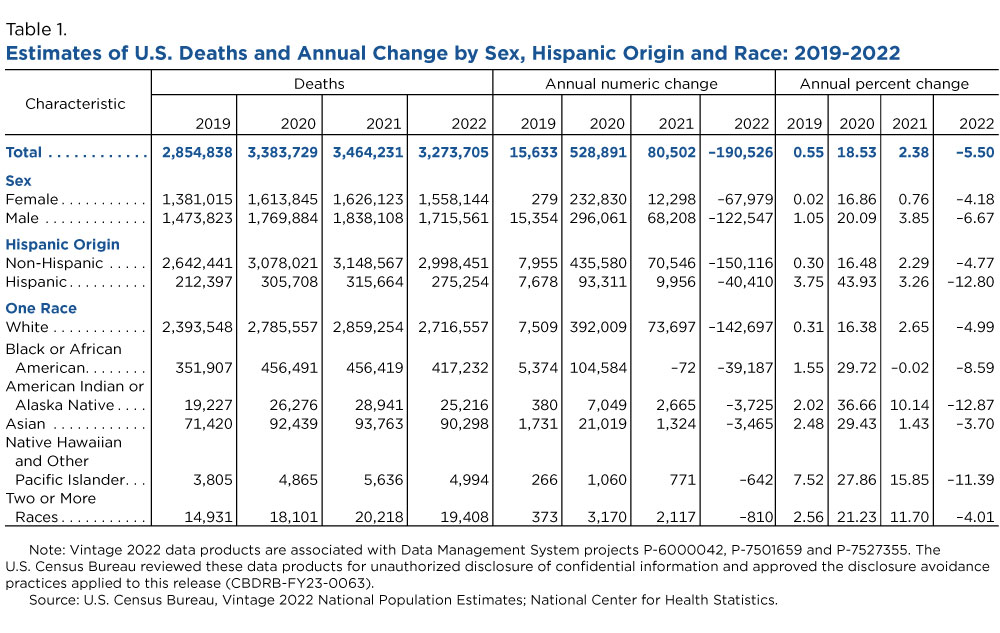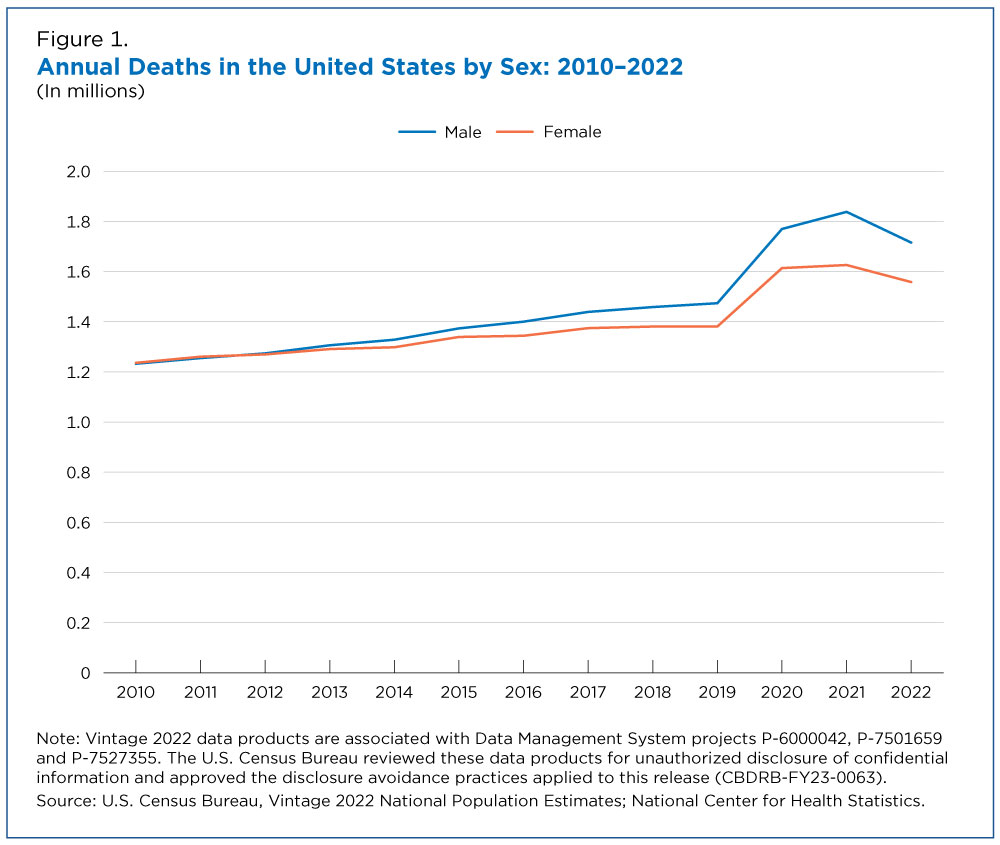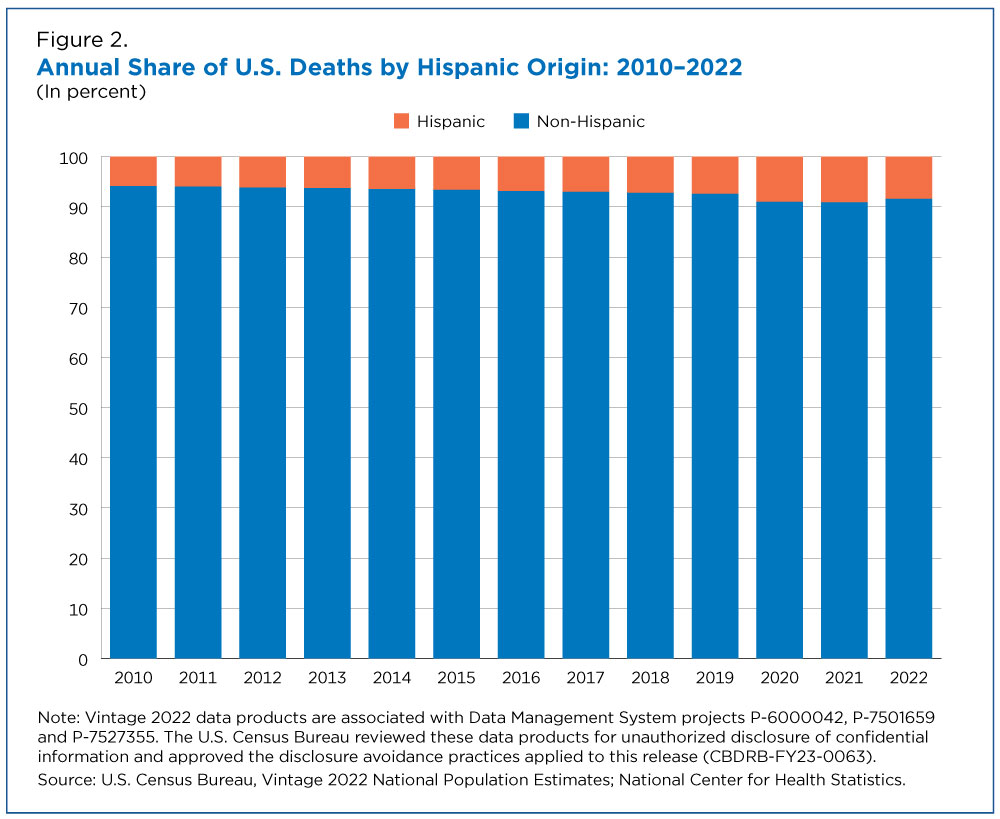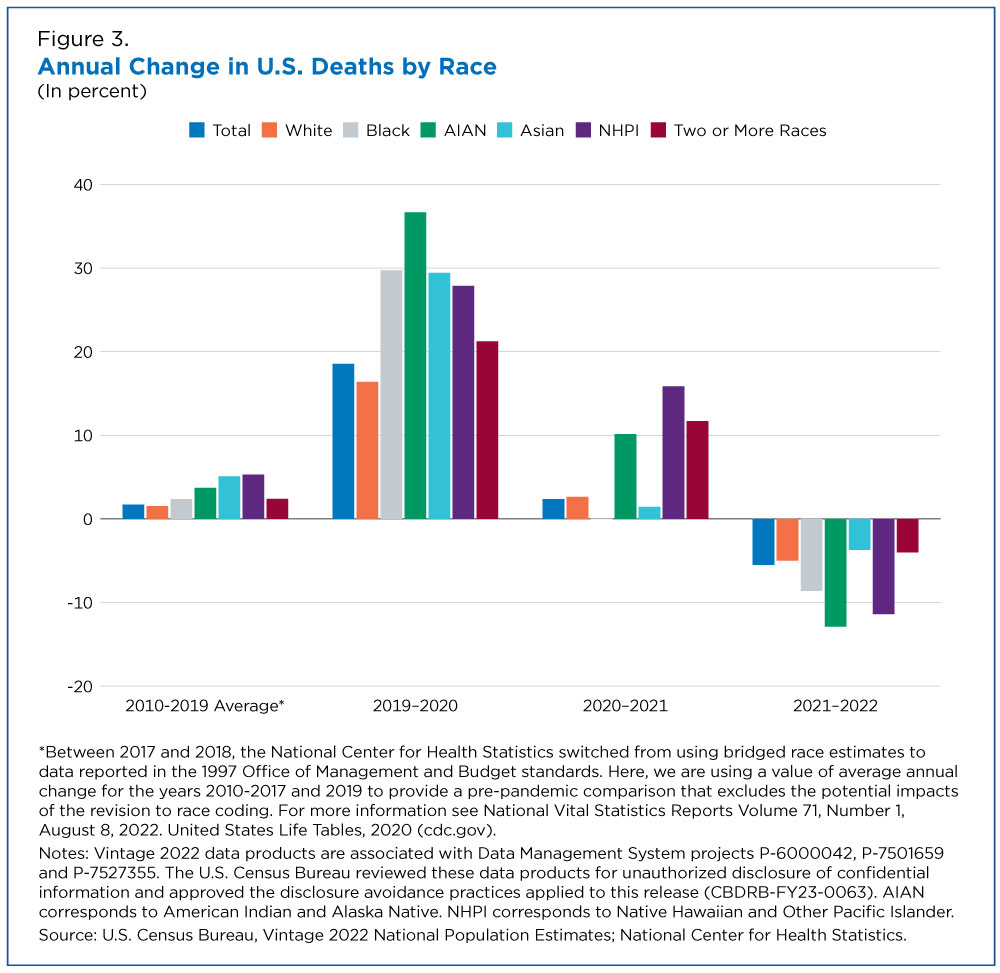Males and the Hispanic, American Indian and Alaska Native (AIAN) populations experienced a disproportionately large number of deaths from 2019 to 2020, the year that includes the start of the COVID-19 pandemic.
Deaths for the total U.S. population increased 19% in 2020, but some groups were more affected than others, according to the U.S. Census Bureau’s Vintage 2022 Population Estimates released today — the first to contain final 2020 mortality data by demographic characteristics.
There were large increases in deaths across all demographic groups between 2019 and 2020 and smaller increases for most groups from 2020 to 2021. Deaths declined for all groups from 2021 to 2022.
Increases in deaths during 2020 were reflected in previous estimates releases, but the latest data show the disproportionate impact of the pandemic on mortality by race/ethnicity and sex.
How We Measure Deaths
The U.S. Census Bureau’s annual estimates are based on final 2020 data and provisional totals from the National Center for Health Statistics (NCHS). To capture more recent trends in deaths during the entire estimates series (April 1, 2020-July 1, 2022), including those from the pandemic, we relied on newly available 2021 final data and 2022 provisional data from NCHS.
These data are subject to revision. The patterns described here, specifically for 2022, may differ slightly from those included in our next vintage estimates (Vintage 2023) which will be updated with final data.
Mortality Trends by Characteristics
There were large increases in deaths across all demographic groups between 2019 and 2020, and smaller increases for most groups from 2020 to 2021 (Table 1). Deaths declined for all groups from 2021 to 2022.
Mortality by Sex
Males have historically had higher deaths than females and for most of the last decade, the gap between the two sexes had been growing prior to the pandemic (Figure 1). In 2012, for example, 50.1% of deaths were male. By 2019, the share had increased to 51.6%.
Between 2019 and 2020, male deaths increased by 296,061 (20.1%) and female deaths by 232,830 (16.9%). The trend continued in 2021, with 68,208 (3.9%) more male deaths and 12,298 (0.8%) more female deaths.
In 2021, 53.1% of those who died were male. Provisional 2022 NCHS data show larger declines for males but the share of male deaths (52.4%) was still larger than in pre-pandemic years.
The growing difference in deaths between males and females in 2020 and 2021 suggests the COVID-19 pandemic had a larger impact on the mortality of males than it did on females.
Hispanic Origin
Because the Hispanic population comprises a much smaller share of the total population relative to the non-Hispanic group, the majority of deaths are non-Hispanic (Figure 2).
Similarly, as the share of the Hispanic population increased from 2010 to 2020, so did the share of deaths among this group, which went from 6.2% in 2012 to 7.0% in 2017 and 7.4% in 2019.
The increase in Hispanic deaths between 2019 and 2020, however, represents a notable break in the time series, jumping from 7.4% to 9.0% of all deaths in a single year. The Hispanic population’s share of mortality increased again (9.1%) in 2021, the first full year of the pandemic.
The increase in Hispanic mortality during the pandemic was higher relative to the non-Hispanic U.S. population, though it declined slightly to 8.4% of total deaths in 2022, according to provisional data.
Race Groups
All race groups had higher-than-normal increases in deaths from 2019 to 2020 (Figure 3). But during the pandemic’s first year, every race group other than the White population experienced single-year percentage increases higher than the 18.5% increase in deaths for the total population.
Prior to the pandemic, mortality increases in the previous decade were relatively small and did not vary as much annually across races (Figure 3).
Figure 3 highlights the following trends in mortality rates:
- In 2020, the largest mortality increase occurred in the American Indian and Alaska Native population (36.7%), followed by the Black (29.7%) and Asian (29.4%) populations.
- In 2021, there was more variation in the magnitude and direction of change across groups. Black deaths decreased by less than 1% between 2020 and 2021, while the Native Hawaiian and Other Pacific Islander (15.9%), Two or More Races (11.7%), and American Indian and Alaska Native (10.1%) populations continued to experience larger percentage increases in deaths than the total population.
- White deaths (2.65%) were also slightly higher than the total increase (2.38%).
- Provisional 2022 data show declines in mortality for all race groups between 2021 and 2022, with the largest declines occurring among the American Indian and Alaska Native (-12.9%) and Native Hawaiian and Other Pacific Islander (-11.4%) populations.
Pandemic’s Impact on National Deaths
The data released today offer the most comprehensive look at the impact of COVID-19 mortality in the Census Bureau’s annual population estimates series to date.
Final 2020 data allowed us to account for mortality differences across race groups during the early years of the pandemic. As more final data become available, we will continue to revise the estimates and improve our understanding of how the pandemic affected the nation’s population.
Of particular interest is whether the declines in deaths for 2022 shown in provisional data will result in a return to pre-pandemic levels for mortality, similar to what we are observing for international and domestic migration.






.jpg)





No hay comentarios.:
Publicar un comentario
Cualquier duda o inquietud, no dudes de expresarla, aqui.